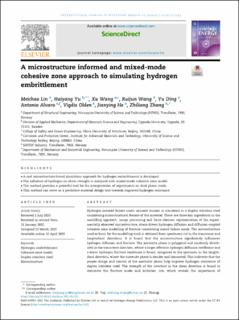| dc.contributor.author | Lin, Meichao | |
| dc.contributor.author | Yu, Haiyang | |
| dc.contributor.author | Wang, Xu | |
| dc.contributor.author | wang, ruijun | |
| dc.contributor.author | Ding, Yu | |
| dc.contributor.author | Alvaro, Antonio | |
| dc.contributor.author | Olden, Vigdis | |
| dc.contributor.author | He, Jianying | |
| dc.contributor.author | Zhang, Zhiliang | |
| dc.date.accessioned | 2022-05-31T07:22:58Z | |
| dc.date.available | 2022-05-31T07:22:58Z | |
| dc.date.created | 2022-03-23T09:50:54Z | |
| dc.date.issued | 2022 | |
| dc.identifier.citation | International Journal of Hydrogen Energy. 2022, 47 (39), 17479-17493. | en_US |
| dc.identifier.issn | 0360-3199 | |
| dc.identifier.uri | https://hdl.handle.net/11250/2996953 | |
| dc.description.abstract | Hydrogen induced failure under uniaxial tension is simulated in a duplex stainless steel considering microstructural feature of the material. There are three key ingredients in the modelling approach: image processing and finite element representation of the experimentally observed microstructure, stress driven hydrogen diffusion and diffusion coupled cohesive zone modelling of fracture considering mixed failure mode. The microstructure used as basis for the modeling work is obtained from specimens cut in the transverse and longitudinal directions. It is found that the microstructure significantly influences hydrogen diffusion and fracture. The austenite phase is polygonal and randomly distributed in the transverse direction, where a larger effective hydrogen diffusion coefficient and a lower hydrogen fracture resistance is found, compared to the specimen in the longitudinal direction, where the austenite phase is slender and laminated. This indicates that the proper design and control of the austenite phase help improve hydrogen resistance of duplex stainless steel. The strength of the interface in the shear direction is found to dominate the fracture mode and initiation site, which reveals the importance of considering mixed failure mode and calibrating the hydrogen induced strength reduction in shear. | en_US |
| dc.language.iso | eng | en_US |
| dc.publisher | Elsevier | en_US |
| dc.rights | Navngivelse 4.0 Internasjonal | * |
| dc.rights.uri | http://creativecommons.org/licenses/by/4.0/deed.no | * |
| dc.subject | Microstructure | en_US |
| dc.subject | Duplex stainless steel | en_US |
| dc.subject | Cohesive zone model | en_US |
| dc.subject | Hydrogen embrittlement | en_US |
| dc.title | A microstructure informed and mixed-mode cohesive zone approach to simulating hydrogen embrittlement | en_US |
| dc.title.alternative | A microstructure informed and mixed-mode cohesive zone approach to simulating hydrogen embrittlement | en_US |
| dc.type | Peer reviewed | en_US |
| dc.type | Journal article | en_US |
| dc.description.version | publishedVersion | en_US |
| dc.rights.holder | © 2022 The Author(s). Published by Elsevier Ltd | en_US |
| dc.source.pagenumber | 17479-17493 | en_US |
| dc.source.volume | 47 | en_US |
| dc.source.journal | International Journal of Hydrogen Energy | en_US |
| dc.source.issue | 39 | en_US |
| dc.identifier.doi | 10.1016/j.ijhydene.2022.03.226 | |
| dc.identifier.cristin | 2011886 | |
| dc.relation.project | Norges forskningsråd: 294689 | en_US |
| dc.relation.project | Norges forskningsråd: 294739 | en_US |
| cristin.ispublished | true | |
| cristin.fulltext | postprint | |
| cristin.fulltext | original | |
| cristin.qualitycode | 1 | |

